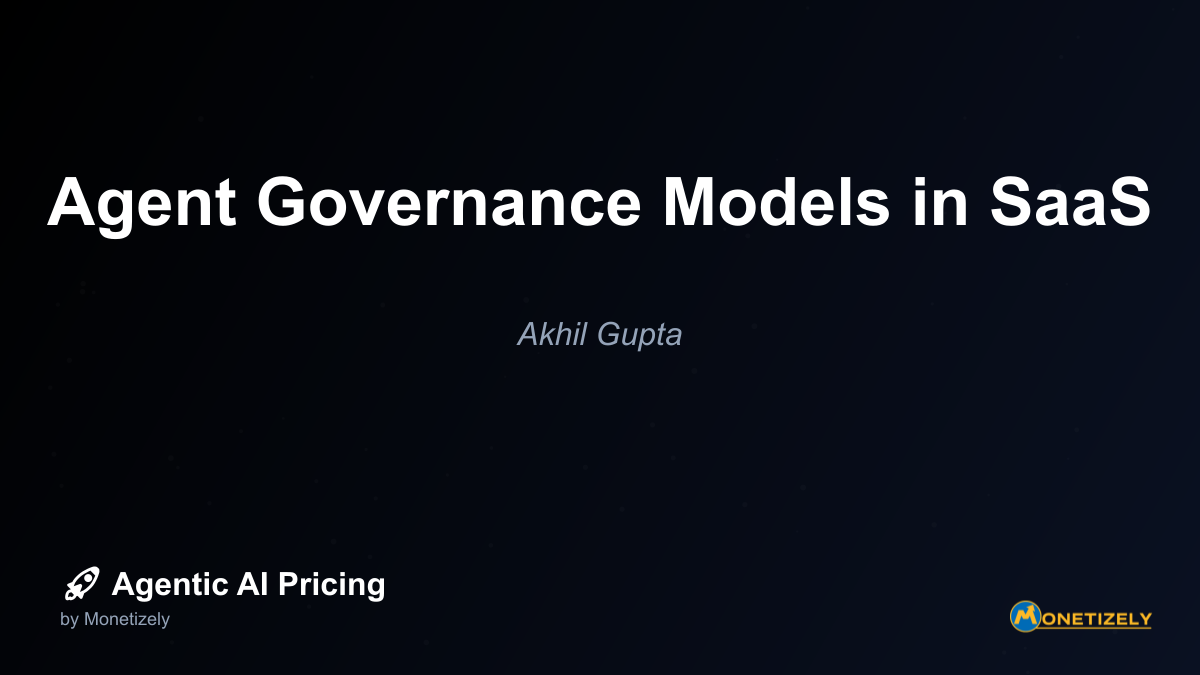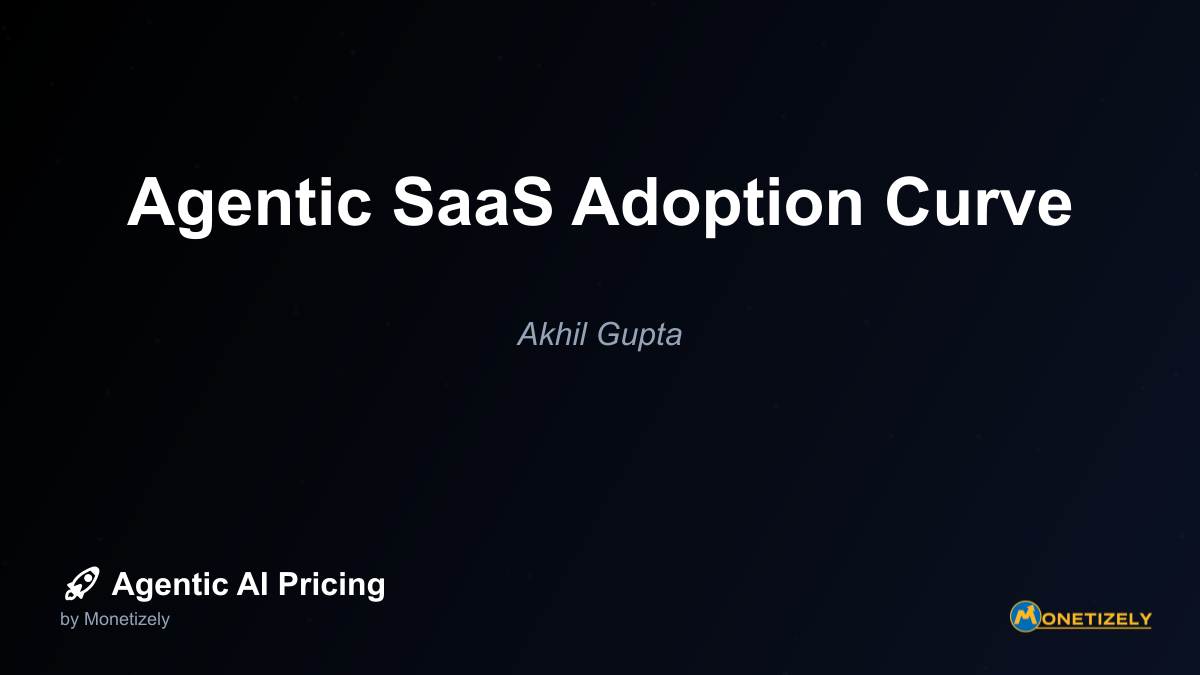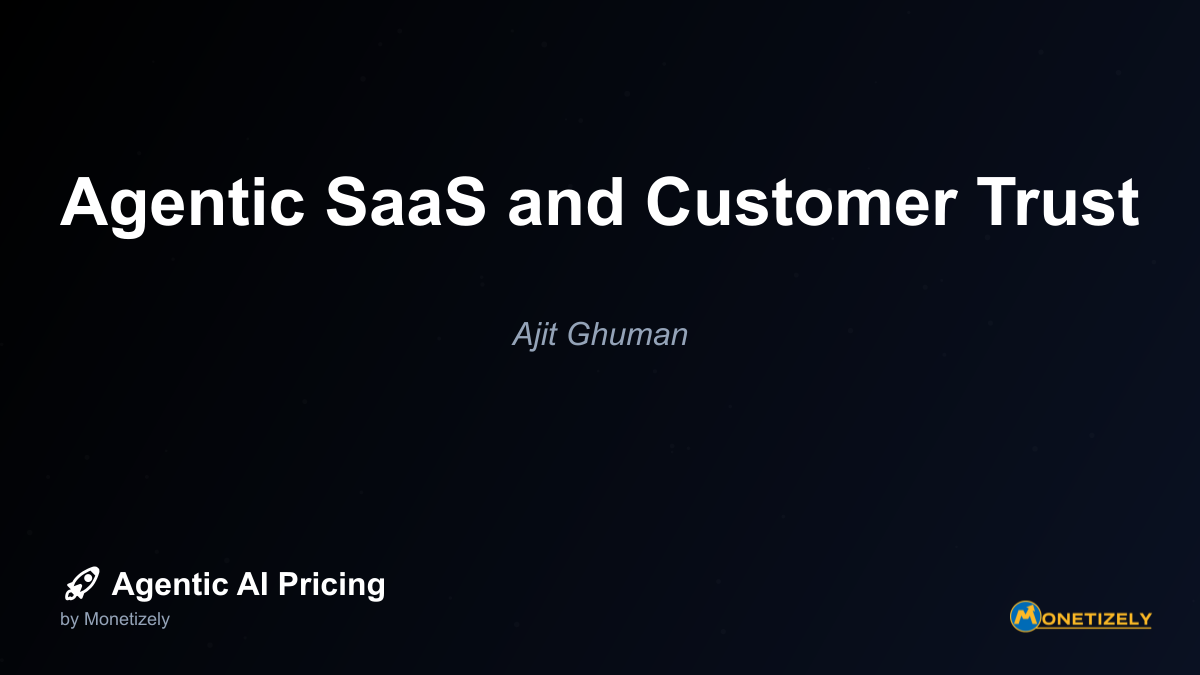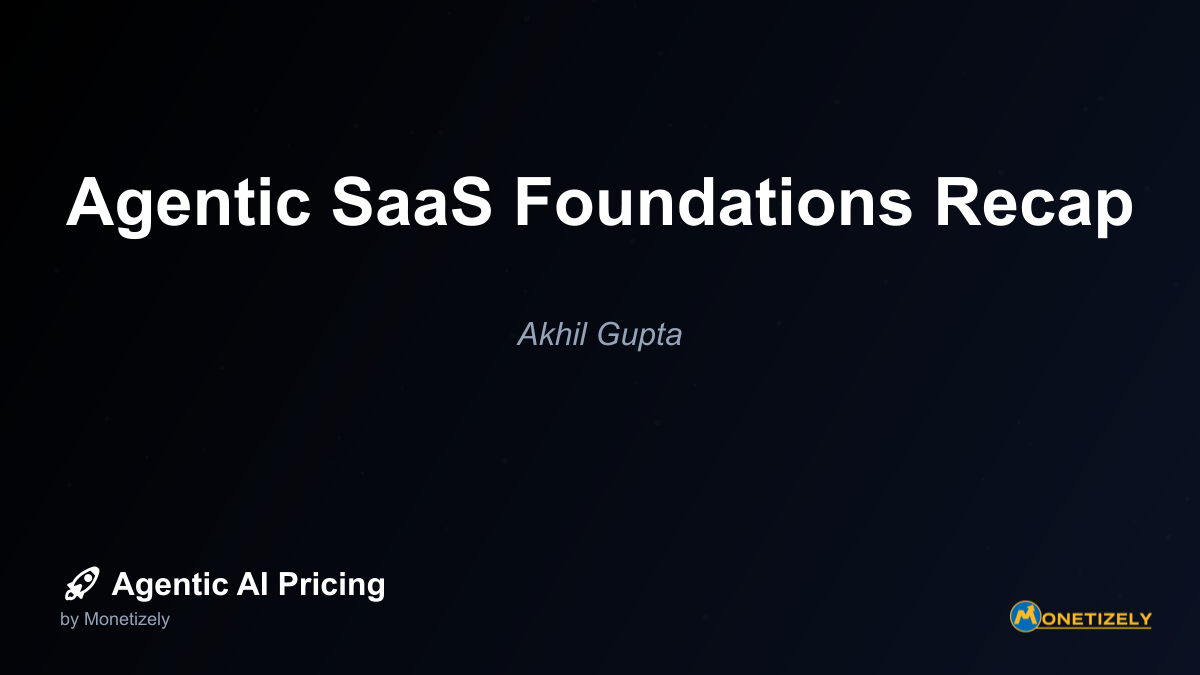· Akhil Gupta · Agentic SaaS Fundamentals · 13 min read
Architecture of Agentic SaaS Explained
AI and SaaS Pricing Masterclass
Learn the art of strategic pricing directly from industry experts. Our comprehensive course provides frameworks and methodologies for optimizing your pricing strategy in the evolving AI landscape. Earn a professional certification that can be imported directly to your LinkedIn profile.
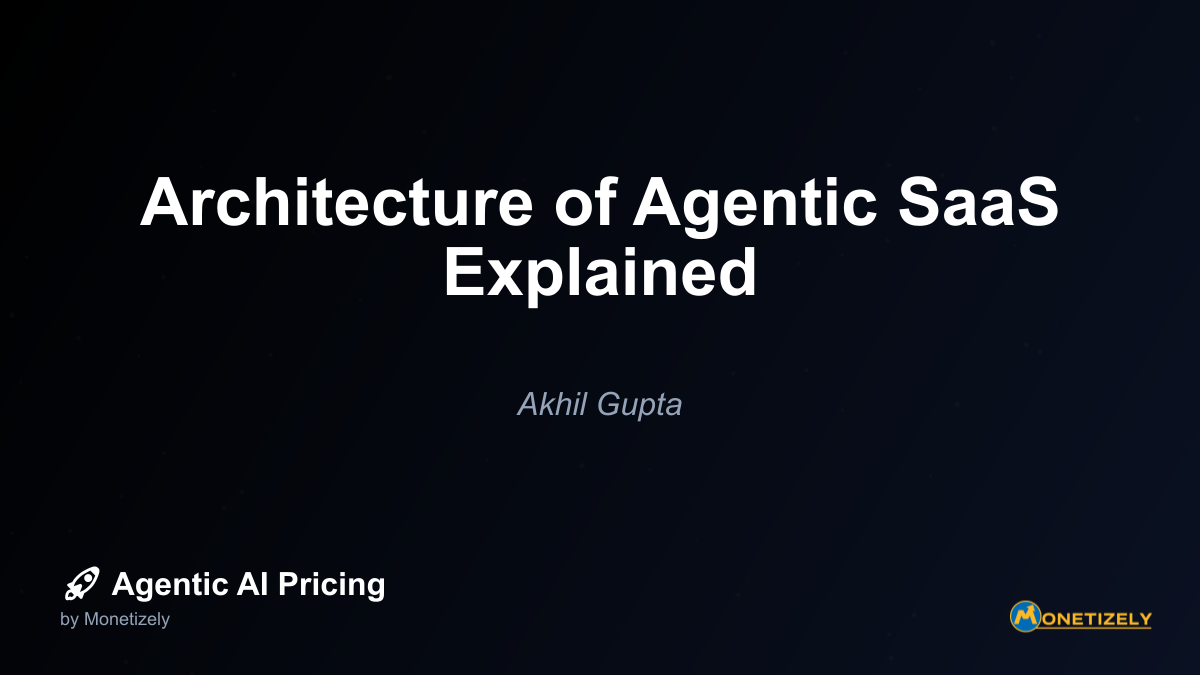
In today’s rapidly evolving technological landscape, agentic SaaS platforms are transforming how businesses operate, automating complex workflows, and enabling unprecedented levels of intelligent decision-making. These sophisticated systems represent the next frontier in software architecture, combining autonomous AI agents, powerful data components, dynamic orchestration systems, and intuitive user experiences.
The Foundation of Agentic SaaS Architecture
At its core, agentic SaaS architecture encompasses four fundamental pillars that work in harmony to create intelligent, autonomous systems capable of executing complex tasks with minimal human intervention.
Data Components: The Bedrock of Intelligence
The data layer forms the foundation upon which all agentic systems are built, comprising several critical elements:
Custom AI Models serve as the specialized intelligence engines trained on domain-specific data to perform targeted tasks. Organizations face a strategic choice between developing proprietary models or leveraging publicly available ones via repositories like Huggingface or NVIDIA NGC. This decision balances control against cost considerations, with many enterprises adopting a hybrid approach to maximize capabilities while managing expenses.
Vector Databases & Storage Solutions address the critical challenge of managing massive amounts of data. These specialized databases convert contextual information into embeddings that enable similarity search and rapid access. Modern architectures typically implement hybrid storage approaches, combining POSIX-based file systems for high-performance real-time access with object storage optimized for hybrid cloud environments.
Metadata & ETL Processes transform raw data through extraction, transformation, and loading workflows to create enriched metadata. This facilitates efficient indexing and retrieval, which proves crucial for both AI training and inference operations. Companies implementing agentic SaaS platforms must invest significantly in these data pipelines, as they directly impact agent performance.
The challenges in building robust data components are substantial. According to industry research, data curation pipelines typically consume 30-50% of project time, with even minor data delays causing significant performance degradation in agentic workflows. Organizations like Qumulo have developed specialized cloud data platforms explicitly targeting petabyte-scale unstructured data management to address these bottlenecks.
Agent Design: The Thinking Core
The agentic AI services layer represents the “brain” of the system, containing multiple specialized components that enable autonomous decision-making and action:
Goal Interpreters transform natural language or high-level user inputs into structured, actionable objectives. This critical component minimizes ambiguity and enables precise task definition, serving as the entry point for user intentions into the system.
Planners develop multi-step task sequences based on dependencies and available tools. Advanced implementations utilize sophisticated planning methods like hierarchical task networks (HTNs) to manage task decomposition and dynamic re-prioritization as conditions change.
Tool Interfaces provide standardized communication channels with external systems, databases, APIs, and services. This extensibility is crucial for integrating agents within broader enterprise ecosystems, allowing them to leverage existing infrastructure.
Memory Systems store session context, user preferences, and previous outputs. This persistent knowledge enables long-term consistency, personalization, and iterative improvement—a key differentiator between simple AI and truly agentic systems.
Evaluators and Feedback Loops continuously assess performance outputs, enabling self-correction, escalation of failures, and iterative refinement of agent behavior without constant human oversight.
Multi-Agent Collaboration Frameworks enable agents to communicate asynchronously, triggering subordinate agents or tools to divide complex workflows into manageable tasks in an event-driven manner.
The agent design landscape has evolved rapidly between 2023 and 2025, with industry leaders like Salesforce’s Agentforce 3 platform and ServiceNow’s AI Agent Orchestrator pioneering different architectural approaches. Salesforce emphasizes natively hosted large language models (LLMs) like Anthropic for lower latency and increased accuracy, while ServiceNow focuses on an AI agent control tower model that orchestrates thousands of specialized AI agents across departments.
Orchestration Systems: The Coordination Layer
The orchestration layer manages the complex interplay between multiple agents, data sources, and external systems:
Asynchronous Event-Driven Workflows replace traditional synchronous request-response patterns with event-based communication. This approach decouples processes and enhances scalability, allowing, for example, an uploaded document to trigger a cascade of AI workflows automatically without blocking other operations.
API Gateways & Integration Layers act as the single entry point for all external and internal requests, managing authentication, rate limiting, and routing to either legacy microservices or AI-powered workflows. This architecture ensures seamless coexistence of traditional and agentic capabilities during transition periods.
Closed-Loop Task Management Systems track goals, subtasks, failure recovery, and prioritization dynamically across workflows to maintain robustness in complex scenarios.
McKinsey’s research describes a new paradigm called the “agentic AI mesh,” an architecture designed to overcome core challenges including managing risks such as uncontrolled autonomy, lack of observability, and expanded attack surfaces. This mesh architecture supports scalability, control, and trust—essential qualities for deploying large agent workforces in complex enterprises.
User Experience: The Human Interface
The user experience layer bridges the gap between human intention and machine execution:
Interface Layers serve as the human-AI interaction point, processing user goals into machine-interpretable formats and delivering coherent, responsive outputs. They ensure clarity and user guidance, including capability explanations and feedback mechanisms.
Personalization & Context Awareness utilizes agent memory to adapt responses over sessions, improving relevance and user satisfaction through increasingly tailored interactions.
Multi-Modal Interaction Support enables diverse input/output formats (text, speech, images) linked with underlying AI models specialized in these domains.
The UX challenges for agentic systems are substantial. Latency issues arise as agentic AI loops are often resource- and time-intensive, making them unsuitable for some real-time, high-volume interactions. Leading implementations address this by exposing low-latency APIs for real-time user engagement while offloading longer agentic workflows asynchronously.
Real-World Implementation: Case Studies and Market Adoption
The period between 2023 and 2025 has seen significant adoption of agentic SaaS architectures across industries, with several standout implementations demonstrating the potential of this technology.
Salesforce – Agentforce 3 Platform
Salesforce’s Agentforce 3 platform showcases an advanced agentic AI architecture combining reasoning, system performance, and trust enhancements. It integrates agents, data, apps, and metadata to create a digital labor platform supporting diverse enterprise use cases such as customer service automation and workflow orchestration.
Implementation Challenges: Ensuring enterprise readiness with low latency, high resiliency, and trust/accountability in AI decisions across widely distributed agents posed significant hurdles.
Outcomes: Thousands of companies leveraged the platform, benefiting from improved intelligence and operator trust. The platform utilizes a vendor ecosystem with 30+ partners (AWS, Google Cloud, IBM, PayPal) for plug-and-play services, enhancing extensibility.
ServiceNow – AI Agent Orchestrator
ServiceNow’s approach revolves around an AI agent control tower model that orchestrates thousands of specialized AI agents across IT, HR, and customer service departments. Its architecture enables inter-agent communication, centralized management, and governance of agentic workflows in a unified SaaS platform.
Implementation Challenges: Managing agent sprawl, ensuring seamless communication between specialized agents, and maintaining governance at scale required innovative architectural solutions.
Outcomes: The platform enabled organizations to unify diverse AI agents’ efforts efficiently, reducing operational chaos and providing a single control plane for monitoring and task handoff. It supports customized agent creation through AI Agent Studio, fostering flexibility and extensibility.
QuantumBlack (McKinsey) – Agentic AI Mesh Architecture
QuantumBlack developed a new paradigm called the agentic AI mesh, designed to overcome three core challenges: managing risks such as uncontrolled autonomy and lack of observability; combining off-the-shelf and custom-built agents tailored to strategic processes; and maintaining agility through vendor-agnostic, evolutive architectures that prevent lock-ins amid rapid tech evolution.
Implementation Challenges: Balancing innovation with risk management and integration complexity presented significant obstacles.
Outcomes: Customers achieved transformative strategic advantage with custom agents uniquely aligned with their business logic and workflows.
Market Statistics and ROI Metrics
The agentic SaaS platform market has expanded rapidly between 2023 and 2025, driven by enterprises seeking automation beyond basic AI augmentation into truly autonomous multi-agent orchestration platforms. Industry research reveals compelling ROI metrics:
- Companies adopting agentic AI in sales processes report a 45% increase in qualified leads and 30% improvement in conversion rates by leveraging autonomous nurturing, presentation customization, and prospect qualification.
- In legal document processing, large law firms using agentic AI reduce document review time by 70% and increase contract compliance accuracy by 85%, mitigating risks missed by manual review approximately 20% of the time.
- Agentic AI-enabled workflow automation reduces bottlenecks and manual load, notably in IT and customer support, improving efficiency and lowering operational costs.
- Environmental optimization implementations contribute to 20-30% reductions in carbon emissions in smart sustainability initiatives at the city district level.
Implementation Costs and Infrastructure Requirements
Implementing agentic SaaS platforms involves significant investment across several key areas:
Development Costs
- Simple systems (e.g., basic AI agents like chatbots): $8,000 to $30,000
- Mid-tier AI agents (recommendation engines, predictive analytics): $50,000 to $150,000
- Advanced and highly specialized agentic AI systems with self-learning capabilities: $60,000 up to $2 million or more
- Custom B2B SaaS agentic AI solutions: $100,000 to $2 million including integration complexity
Infrastructure Costs
- Cloud infrastructure platforms (AWS, Azure, GCP) provide flexible compute, storage, and data bandwidth but come with recurring costs that can increase by 200-400% initially due to real-time processing and large data handling needs.
- On-premise deployments demand significant upfront setup costs and ongoing maintenance, often more expensive than cloud in initial phases but might offer longer-term cost controls.
- Data preparation and management, necessary for effective agentic AI, can add $50,000 to $500,000 based on data volume and quality.
ROI Timelines and Optimization Strategies
ROI timelines vary with project scale and integration complexity, but accelerated returns can typically be expected within 12 to 24 months due to cost savings from automation, enhanced decision-making, and productivity gains.
Key optimization strategies include:
- Opting for cloud-based infrastructure to reduce upfront capital expenditure and scale resources on demand
- Implementing modular and clean integrations to prevent expensive refactoring and maintain long-term flexibility
- Prioritizing data quality and preparation upfront to lower downstream maintenance costs and improve AI effectiveness
- Establishing continuous monitoring and adjustment post-deployment to optimize agent performance and maximize ROI over time
Technical Implementation Challenges
Organizations implementing agentic SaaS architectures face several significant technical challenges across the core components:
Data Component Challenges
- Unified, High-Performance Data Platforms: Agentic AI depends heavily on feeding multiple AI agents with diverse, often unstructured datasets that are commonly siloed, creating pipeline complexity, data fragmentation, and performance bottlenecks.
- Data Curation and Latency: Continuous learning workflows require rapid, adaptive data delivery to multiple models simultaneously, with even minor data delays slowing agentic workflows.
- Context Management: Avoiding context collapse, where fragmented or diluted contextual information reduces decision quality, requires sophisticated context propagation mechanisms.
Agent Design Challenges
- Multi-Agent Coordination: Designing agents as collaborative components capable of coordinating activities via agentic flows requires sophisticated communication and orchestration mechanisms.
- Custom vs. Off-the-Shelf Agents: Balancing the use of readily available agents against the development of custom agents aligned with specific business logic presents strategic challenges.
- Managing Agent Sprawl and Risks: Controlling agent proliferation, duplication, and ensuring observability across autonomous systems introduces complexity absent from traditional architectures.
Orchestration System Challenges
- Architecture Shift: Moving from transactional, static workflows to dynamic, conversation- and collaboration-driven flows requires fundamental architectural redesign.
- Control, Scalability, and Trust: Building robust control mechanisms to monitor agent decisions, ensure explainability, and enable horizontal scaling across enterprise environments demands sophisticated engineering.
- Vendor Agnosticism: Creating flexible architectures that avoid vendor lock-in while supporting multi-platform workflows presents integration challenges.
User Experience Challenges
- Latency and Multimodality: Managing resource-intensive agentic AI loops that may not suit real-time interactions requires careful interface design and asynchronous processing strategies.
- Explainability and Traceability: Building trust through transparent decision-making and comprehensive audit trails as AI models evolve autonomously requires specialized tooling.
- Workflow Integration: Seamlessly orchestrating complex workflows spanning multiple SaaS domains while maintaining consistent user experience demands sophisticated integration.
The Competitive Landscape: Major Players and Their Approaches
The agentic SaaS architecture landscape has seen intense competition among major technology players, each leveraging their unique strengths to establish dominance:
OpenAI
Focuses on providing foundation models with fine-tuned agents and API-based extensibility. Their approach leverages the GPT family of LLMs to create versatile agents for code, language, and reasoning tasks. OpenAI’s strategy emphasizes flexible, domain-agnostic agent APIs for broad customization across SaaS implementations.
Microsoft
Concentrates on integrating agentic AI deeply with their cloud platform (Azure) and software stack. Through collaborations with OpenAI and deployment of AI agents across Microsoft 365 and Power Platform, Microsoft’s architecture unifies agents with enterprise data and applications, emphasizing scalability and vendor-agnosticism.
Prioritizes advanced agent orchestration via Google Cloud AI services, introducing enhanced “Agentforce 3” Atlas architecture supporting LLM hosting (Anthropic), reasoning, and trust features. Google combines proprietary LLMs with open ecosystems, emphasizing performance, trust, and multi-agent coordination.
Salesforce
Develops agentic AI platforms (Agentforce series) integrating CRM and business applications. Their Agentforce 3 platform enables unified agents, metadata integration, and an extensive partner marketplace with 30+ vendors. Salesforce focuses on domain-specific AI agents tightly woven into SaaS domains like CRM and customer service with strong governance frameworks.
Future Trends and Predictions
The future of agentic SaaS architecture points toward several transformative trends:
Widespread Adoption by 2027
By 2027, most enterprise SaaS companies are expected to adopt or pilot agentic AI systems that autonomously manage ideation, design, development, and optimization phases of SaaS products. This shift moves beyond incorporating isolated AI features to architecting entire product lifecycles around continuous autonomous agents.
Evolution of Agentic AI Mesh Architecture
The agentic AI mesh paradigm will continue to evolve, orchestrating multiple agents across diverse systems while ensuring control, observability, resilience, and interoperability. This architecture will need to handle risks such as uncontrolled autonomy, fragmented access, and agent duplication while blending custom-built and off-the-shelf agents.
Shift from Static SaaS to Dynamic AI-Driven Systems
Traditional SaaS layers with separate data repositories and business logic will give way to AI-centric decisioning layers. Business logic will increasingly be compressed into autonomous agents that orchestrate work by interacting directly with distributed data across systems, collapsing legacy application silos.
Autonomous Product Development and Optimization
Agentic AI will move from manual and reactive processes to continuous scanning of market trends, user needs, and competitor actions; autonomous UX design and code generation; and proactive system performance management. This will fundamentally change how software evolves over time.
Regulatory and Governance Considerations
As agentic SaaS platforms become more prevalent, several regulatory and governance considerations emerge:
Systemic Risk Management
Agentic AI architectures must prioritize observability, audit trails, and fine-grained access control to mitigate risks from autonomous actions and widespread agent deployment. This becomes increasingly important as agents gain more autonomy and responsibility.
Compliance and Trust Frameworks
As agent autonomy grows, regulatory frameworks around data privacy, AI explainability, and ethical AI usage are emerging. Architectures increasingly embed compliance-first design—including role-based access, error handling, and comprehensive logging—to maintain accountability.
Vendor Lock-in Avoidance
Industry experts underscore the need for vendor-agnostic, evolutive architectures that allow enterprises to blend custom and off-the-shelf agents without being locked into proprietary ecosystems. This flexibility will be crucial as the technology landscape continues to evolve rapidly.
Conclusion: The Transformative Potential of Agentic SaaS Architecture
Agentic SaaS architecture represents a paradigm shift in how software systems are designed, deployed, and utilized. By integrating sophisticated data components, intelligent agent design, dynamic orchestration systems, and intuitive user experiences, these platforms enable levels of automation and intelligence previously unattainable.
The evidence from market adoption, case studies, and ROI metrics clearly demonstrates the transformative potential of this architectural approach. Organizations implementing agentic SaaS platforms report significant improvements in efficiency, accuracy, and decision-making capabilities, with ROI typically realized within 12-24 months.
However, successful implementation requires careful consideration of technical challenges, infrastructure requirements, and governance frameworks. Organizations must balance the benefits of off-the-shelf components against the strategic advantages of custom-built agents, while ensuring robust data pipelines, effective orchestration mechanisms, and seamless user experiences.
As the technology continues to evolve, staying informed about emerging trends, competitive developments, and regulatory considerations
Co-Founder & COO
Akhil is an Engineering leader with over 16+ years of experience in building, managing and scaling web-scale, high throughput enterprise applications and teams. He has worked with and led technology teams at FabAlley, BuildSupply and Healthians. He is a graduate from Delhi College of Engineering and UC Berkeley certified CTO.
Pricing Strategy Audit
Let our experts analyze your current pricing strategy and identify opportunities for improvement. Our data-driven assessment will help you unlock untapped revenue potential and optimize your AI pricing approach.

